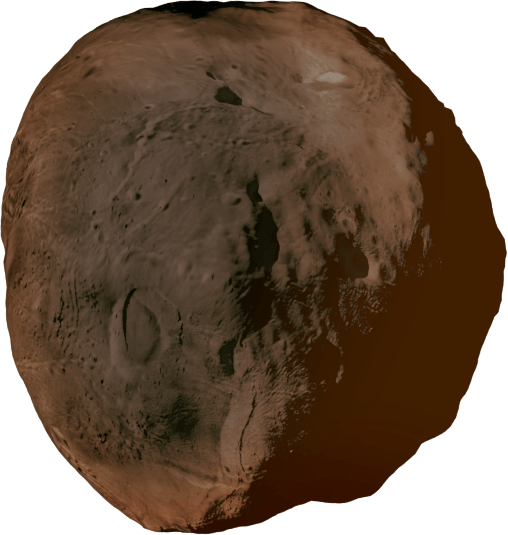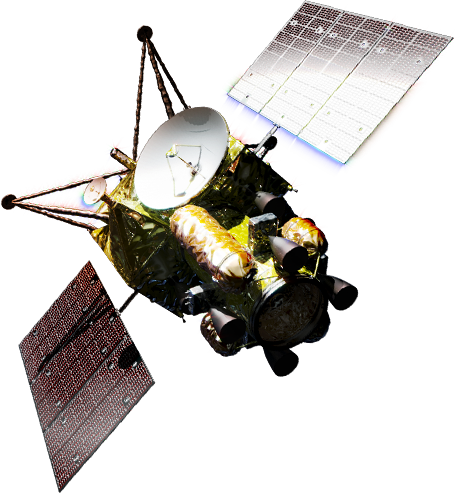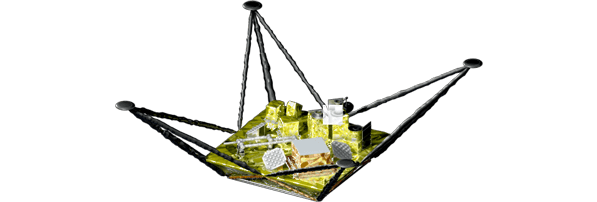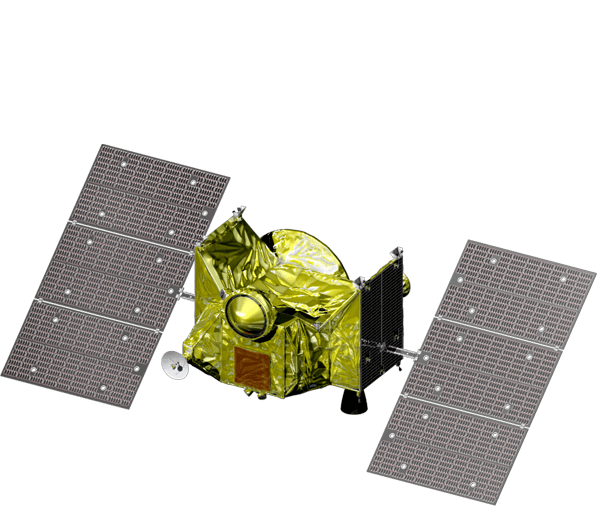

Mission to travel to
Mars and survey the red planet’s two moons;
Phobos and Deimos.
The spacecraft will explore both moons and collect a sample
from Phobos to bring
back to Earth.
MMX News
What’s MMX?
The Martian Moons eXploration (MMX) mission is a project to explore the two moons of Mars, with a planned launch in the mid-2020s. Approximately one year after leaving Earth, the spacecraft will arrive in Martian space and enter into an orbit around Mars. It will then move into a Quasi Satellite Orbit (QSO) around the Martian moon, Phobos, to collect scientific data and gather a sample from the moon’s surface. After observation and sample collection, the spacecraft will return to Earth carrying the material gathered from Phobos. The current schedule has a launch date in JFY 2026, followed by Martian orbit insertion in JFY 2027 and the spacecraft will return to Earth in JFY 2031.
Exploration of the Martian moons will help improve technology for future planet and satellite exploration. For example, advancement in the technology required to make round-trips between the Earth and Mars, the advanced sampling techniques that will be employed on the Martian moon surface and in the optimal communication technology using the Deep Space Network ground stations.
A major scientific goal for the mission is clarifying the origin of the two Martian moons and the evolution process of the Martian Sphere (Mars, Phobos and Deimos). The creation of this system is one of the keys to solving the mysteries of planetary formation in the Solar System.



Objective
The objectives of the MMX mission are to explore the origins of the Martian moons, the creation of habitable environments where life could begin, to learn about the evolutionary history of the Martian sphere, and to develop technology to form a foundation for future exploration activities.
Planetary Science
- Investigate the origin of the Martian moons, and provide constraints on the planet formation process and the transport of material through the juncture between the inner and outer Solar System.
- From the perspective of the Martian moons, explore the mechanisms that drive the evolution of the Martian system, and gain new insights into the history of Mars itself.
Aquire Exploration Technology
- Required for the return journey to the Martian sphere and to entre the planet orbit.
- To land and remain on the surface of the Martian moon, and to engage advanced sampling techniques on the surface of celestial bodies.
- For optimal communication in combination with the new exploration ground station.
In addition to the principal mission objectives, ripples from the MMX mission are expected to extend to the science of the Martian surface, future crewed Mars exploration, and the dissemination of exploration activities. MMX is a unique exploration of the Mars sphere by Japan.
Three additional oppertunities
- Transmit images from the Martian sphere with the Super Hi-Vision (SHV) cameras: Jointly developed by NHK and JAXA, the two SHV cameras will capture 4K and 8K resolution images of Mars and its two moons to send to Earth. These images will be a window to share the journey to the Martian moons around the world.
- Fragments of Mars meteorites on Phobos likely included in sample: The surface of Phobos is expected to be covered with meteorite fragments originating from the surface of Mars. Mars meteorite material that is gathered in the sample collected from Phobos could potentially constrain the chemical composition of the Martian surface layers and their history.
- With Phobos as a bridgehead to Mars, MMX is a vanguard for crewed Mars exploration. The return trip to Mars by MMX will be an essential component of future rewed Mars exploration. MMX will also perform the first detailed observations of the surface topology, ground conditions, and surrounding environment of Phobos, which is considered a possible site for a human base as a natural space station.
Probe
To achieve the purpose of the MMX mission, the spacecraft needs to achieve various requirements. After separating from the launch rocket, the spacecraft must satisfy:
- Important requirements to maintain the spacecraft funcationality, such as electric power, heat, and communication with the Earth.
- Requirements from the science instruments, such as altitude and timing of scientific observations.
In-depth studies are being conducted to design a spacecraft that meets these requirements.
Science
In addition to collecting samples, MMX will also perform remote sensing of Mars and its moons using a suite of observational instruments. It is still not clear how the two small Martian moons were formed and what processes they have undergone. The surface of Phobos seen in visible and near infrared light is not uniform, suggesting the possibility of different constituent materials. Discussions are being held with both Japanese and international scientists to determine where samples should be collected. Observational data obtained by the remote sensing instruments onboard MMX will be used to determine the sampling locations.
WorkingTeams
In the MMX project, the spacecraft system and science teams collaborate in working groups aimed at solving numerous difficult and challenging tasks.
Landing Operation Working Team
LOWT is a team consisting of system and science experts who conduct research studies related to the Martian moons landing operation.
Mission Operation Working Team
MOWT and the Mission Operation Preparation Working Team (MOPWT) study science measurement operation planning and feasibility.
Data Processing Working Team
DPWT studies issues relating to the ground data processing of mission data sent from the spacecraft.
Rover Operation Working Team
ROWT conducts studies related to the operation of the on-board MMX rover that will explore Phobos.
Landing Site SelectionWorking Team
LSSWT discusses considerations related to the selection of landing sites on Phobos.
Sample Analysis Working Team
SAWT members research topics related to the analysis of the sample MMX will return from Phobos.



